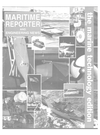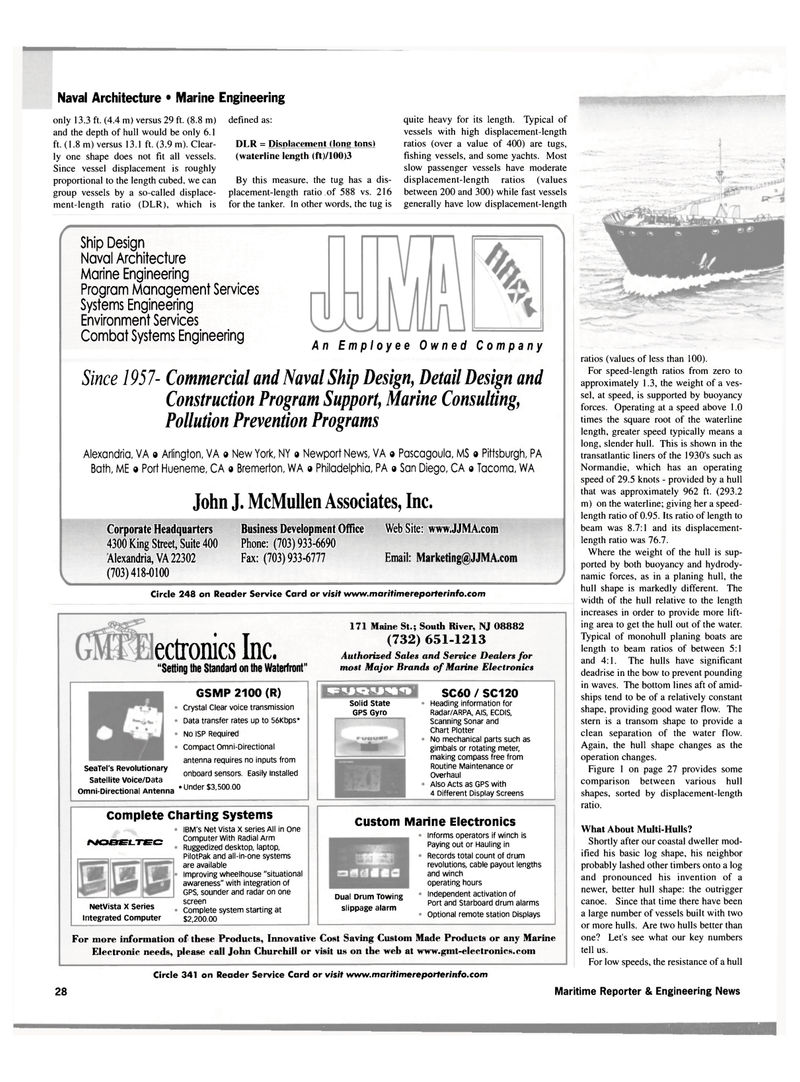
Page 28: of Maritime Reporter Magazine (September 2002)
Read this page in Pdf, Flash or Html5 edition of September 2002 Maritime Reporter Magazine
Naval Architecture • Marine Engineering only 13.3 ft. (4.4 m) versus 29 ft. (8.8 m) and the depth of hull would be only 6.1 ft. (1.8 m) versus 13.1 ft. (3.9 m). Clear- ly one shape does not fit all vessels.
Since vessel displacement is roughly proportional to the length cubed, we can group vessels by a so-called displace- ment-length ratio (DLR), which is defined as:
DLR = Displacement (long tons) (waterline length (ft)/100)3
By this measure, the tug has a dis- placement-length ratio of 588 vs. 216 for the tanker. In other words, the tug is quite heavy for its length. Typical of vessels with high displacement-length ratios (over a value of 400) are tugs, fishing vessels, and some yachts. Most slow passenger vessels have moderate displacement-length ratios (values between 200 and 300) while fast vessels generally have low displacement-length
Ship Design
Naval Architecture
Marine Engineering
Program Management Services
Systems Engineering
Environment Services
Combat Systems Engineering An Employee Owned Company
Since 1957- Commercial and Naval Ship Design, Detail Design and
Construction Program Support, Marine Consulting,
Pollution Prevention Programs
Alexandria, VA o Arlington, VA « New York, NY o Newport News, VA a Pascagoula, MS » Pittsburgh, PA
Bath, ME a Port Hueneme, CA » Bremerton, WA o Philadelphia, PA o San Diego, CA 0 Tacoma, WA
John J. McMullen Associates, Inc.
WebSite: www.JJMA.com Corporate Headquarters Business Development Office 4300 King Street, Suite 400 Phone: (703) 933-6690
Alexandria, VA 22302 Fax: (703) 933-6777 (703)418-0100
Email: [email protected]
Circle 248 on Reader Service Card or visit www.maritimereporterinfo.com ectronics Inc. "Setting the Standard on the Waterfront" 171 Maine St.; South River, NJ 08882 (732) 651-1213
Authorised Sales and Service Dealers for most Major Brands of Marine Electronics
SeaTel's Revolutionary
Satellite Voice/Data
Omni-Directional Antenna
GSMP 2100 (R)
Crystal Clear voice transmission
Data transfer rates up to 56Kbps*
No ISP Required
Compact Omni-Directional antenna requires no inputs from onboard sensors. Easily Installed • Under $3,500.00
FURUmi
Solid State
GPS Gyro
SC60 / SC120
Heading information for
Radar/ARPA, AIS, ECDIS,
Scanning Sonar and
Chart Plotter
No mechanical parts such as gimbals or rotating meter, making compass free from
Routine Maintenance or
Overhaul
Also Acts as GPS with 4 Different Display Screens
Complete Charting systems
NOSELTEC
NetVista X Series
Integrated Computer
IBM's Net Vista X series All in One
Computer With Radial Arm
Ruggedized desktop, laptop,
PilotPak and all-in-one systems are available
Improving wheelhouse "situational awareness" with integration of
GPS, sounder and radar on one screen
Complete system starting at $2,200.00
Custom Marine Electronics
Informs operators if winch is
Paying out or Hauling in
Records total count of drum revolutions, cable payout lengths and winch operating hours
Independent activation of
Port and Starboard drum alarms
Optional remote station Displays
Dual Drum Towing slippage alarm
For more information of these Products, Innovative Cost Saving Custom Made Products or any Marine
Electronic needs, please call John Churchill or visit us on the web at www.gmt-electronics.com ratios (values of less than 100).
For speed-length ratios from zero to approximately 1.3, the weight of a ves- sel, at speed, is supported by buoyancy forces. Operating at a speed above 1.0 times the square root of the waterline length, greater speed typically means a long, slender hull. This is shown in the transatlantic liners of the 1930's such as
Normandie, which has an operating speed of 29.5 knots - provided by a hull that was approximately 962 ft. (293.2 m) on the waterline; giving her a speed- length ratio of 0.95. Its ratio of length to beam was 8.7:1 and its displacement- length ratio was 76.7.
Where the weight of the hull is sup- ported by both buoyancy and hydrody- namic forces, as in a planing hull, the hull shape is markedly different. The width of the hull relative to the length increases in order to provide more lift- ing area to get the hull out of the water.
Typical of monohull planing boats are length to beam ratios of between 5:1 and 4:1. The hulls have significant deadrise in the bow to prevent pounding in waves. The bottom lines aft of amid- ships tend to be of a relatively constant shape, providing good water flow. The stern is a transom shape to provide a clean separation of the water flow.
Again, the hull shape changes as the operation changes.
Figure 1 on page 27 provides some comparison between various hull shapes, sorted by displacement-length ratio.
What About Multi-Hulls?
Shortly after our coastal dweller mod- ified his basic log shape, his neighbor probably lashed other timbers onto a log and pronounced his invention of a newer, better hull shape: the outrigger canoe. Since that time there have been a large number of vessels built with two or more hulls. Are two hulls better than one? Let's see what our key numbers tell us.
For low speeds, the resistance of a hull
Circle 341 on Reader Service Card or visit www.maritimereporterinfo.com 28 Maritime Reporter & Engineering News

 27
27

 29
29
